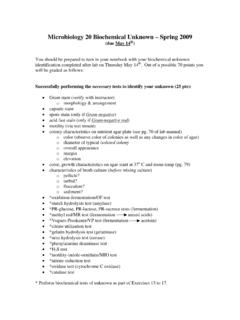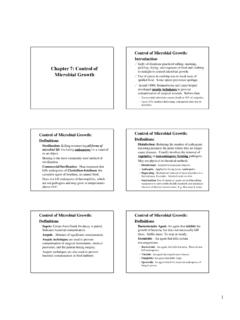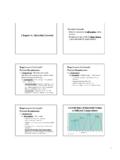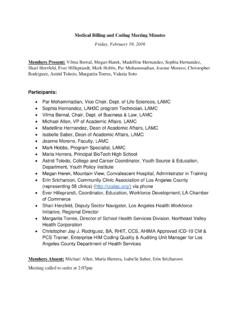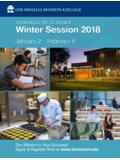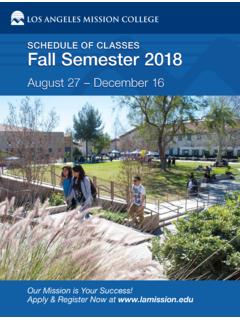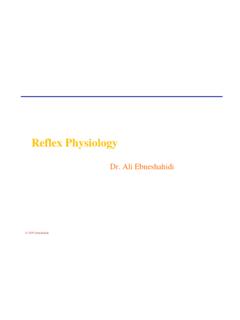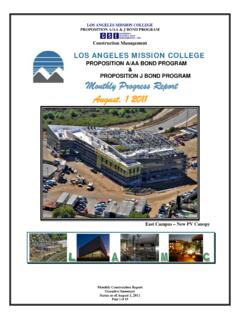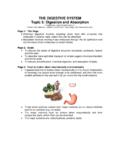Transcription of The Digestive System
1 Copyright 2006 Pearson Education, Inc., publishing as Benjamin CummingsThe Digestive SystemDr. Ali EbneshahidiCopyright 2006 Pearson Education, Inc., publishing as Benjamin CummingsFunctions of the Digestive System ingestion the oral cavity allows food to enter the Digestive tract and have mastication (chewing) occurs , and the resulting food bolus is swallowed . digestion : Mechanical digestion muscular movement of the Digestive tract (mainly in the oral cavity and stomach) physically break down food into smaller particles . chemical digestion hydrolysis reactions aided by enzymes(mainly in the stomach and small intestine) chemically break down food particles into nutrient molecules , small enough to be absorbed.
2 Copyright 2006 Pearson Education, Inc., publishing as Benjamin Cummings Secretion enzymes and Digestive fluids secreted by the Digestive tract and its accessory organs facilitate chemical digestion . Absorption passage of the end products (nutrients) of chemical digestion from the Digestive tract into blood or lymph for distribution to tissue cells . Elimination undigested material will be released through the rectum and anus by defecation . Copyright 2006 Pearson Education, Inc., publishing as Benjamin CummingsOrganization of The Digestive System Organs of the Digestive System are divided into 2 main group : the gastrointestinal tract (GI tract) and accessory structures . GI tract is a continuous tube extending through the ventral cavity from the mouth to the anus it consists of the mouth , oral cavity , oropharynx , esophagus , stomach , small intestine , large intestine , rectum , and anus.
3 Accessory structures include the teeth, tongue (in oral cavity) , salivary glands , liver , gallbladder , and pancreas . Copyright 2006 Pearson Education, Inc., publishing as Benjamin CummingsFigure 2006 Pearson Education, Inc., publishing as Benjamin CummingsMuscular movement of the GI tract Peristalsis wavelike movement that occurs from the oropharynx to the rectum , allowing GI tract to push food particles toward the anus . Mixing mixing motion in the oral cavity and stomach that allows the GI tract to repeatedly break down food into smaller particles , using mechanical digestion . Segmentation regions of the small intestine contracting and relaxing independently , allowing the small intestine to Digestive and absorb more efficiently.
4 Copyright 2006 Pearson Education, Inc., publishing as Benjamin CummingsHistology of the Alimentary CanalFigure 2006 Pearson Education, Inc., publishing as Benjamin CummingsPeristalsis and SegmentationFigure 2006 Pearson Education, Inc., publishing as Benjamin CummingsRegulation of GI Tract Activities Autonomic nervous System -parasympathetic nerves stimulate GI tract activities . -sympathetic nerves inhibit GI tract activities . Hormonal control -hormones from endocrine gland and from GI tract itself help regulate GI tract activities . Reflex mechanism -regions of the GI tract (especially the stomach and small intestine) use reflexes to stimulate or inhibit one another .Copyright 2006 Pearson Education, Inc.
5 , publishing as Benjamin CummingsNervous Control of the GI TractCopyright 2006 Pearson Education, Inc., publishing as Benjamin CummingsMouth & Oral Cavity Food enters the GI tract by ingestion . Food is broken down by mechanical digestion , using mastication . One chemical Digestive process occur where amylaseenzyme in saliva breaks down polysaccharide into disaccharides . The tongue , made of skeletal muscle, manipulates the food during mastication . it also contains taste buds to detect taste sensations(intrinsic) . Food particles are mixed with saliva during mastication , resulting in a moist lump called bolus for easier passage into or pharynx . Copyright 2006 Pearson Education, Inc., publishing as Benjamin CummingsTeeth Adapted for mechanical digestion (mastication) in the oral cavity.
6 20 deciduous or primary teeth before the age of 6. By age 7, 32 permanent or secondary teeth are developed & are divided into 4 types: incisors(for cutting) , Canines(for tearing) , Premolars(for crushing), and Molars(for grinding). these teeth follow the human dental formula of 2006 Pearson Education, Inc., publishing as Benjamin CummingsSalivary Glands 3 pairs of salivary glands called parotid, submandibular, and sublingualgland secrete most of the saliva in the oral cavity , using salivary ducts . Saliva helps moisten the food during mastication , dissolve the food in forming the bolus , and help cleanse the teeth. Saliva consists of water , the remaining is dissolved substances including amylaseenzyme (for chemically digesting carbohydrate ), bicarbonate ion (HCO3-; maintains pH of saliva at ) , and many 2006 Pearson Education, Inc.
7 , publishing as Benjamin CummingsSalivary GlandsFigure 2006 Pearson Education, Inc., publishing as Benjamin CummingsStomach A pouch-like organ primarily designed for food storage (for 2-4 hours) , some mechanical and chemical digestion also occur . Contains two sphincters at both ends to regulate food movement cardiac sphincternear the esophagus ,and pyloric sphincternear the small intestine . Divided into 4 regions : cardiac stomach (or cardiac), fundic stomach (or funded) , body of stomach , and pyloric stomach (or Pylorus). Contain thick folds called rugae at its layer , for providing larger surface area for expansion , secretion , digestion , and some 2006 Pearson Education, Inc., publishing as Benjamin CummingsStomachCopyright 2006 Pearson Education, Inc.
8 , publishing as Benjamin CummingsGastric Secretory Cells -Chief cells:secrete pepsinogen (an inactive enzyme). -Parietal cells: secrete hydrochloric and (HCl) and "intrinsic factor" (which helps absorption of vitamin B12in the intestines). -Mucous cells: secrete mucus and alkaline substances to help neutralize HCl in the gastric juice . -G cells: secrete a hormone called gastrin, which stimulates the parietal cells and overall gastric secretion . Copyright 2006 Pearson Education, Inc., publishing as Benjamin CummingsGastric CellsCopyright 2006 Pearson Education, Inc., publishing as Benjamin CummingsChemical digestion & absorption in the stomach -Carbohydrate digestion is continued with gastric amylase, resulting in disaccharides.
9 -Protein digestion begins with pepsin(activation of pepsinogen by HCl) , resulting in peptides (small chains of protein). -Lipid digestion begins with gastric lipases which can only break down certain lipids such as butterfat , resulting in fatty acids . Absorption in the stomach is limited, where only small and fat-soluble substances can be absorbed water , alcohol, aspirin , and certain drugs . The result of all these mixing , chemical digestion , secretion, and absorption is a yellowish paste called chyme, which will be passed on to the small intestine .Copyright 2006 Pearson Education, Inc., publishing as Benjamin CummingsRegulation of Gastric Secretion Regulation of gastric secretion and activities is by both nervous and hormonal mechanisms food moving along the oral cavity and esophagus stimulates the parasympathetic nerves to activate the secretion in gastric glands , the gastric hormone from G cells in turn stimulates the gastric glands for more activities ("positive feedback").
10 On the other hand , when food is emptying from the stomach , sympathetic nervesinhibit the gastric glands and gastric , and a hormone called intestinal gastrin(released by small intestine) inhibits other gastric activities. The above regulations occur in 3overlapping phases: Cephalic Phase, Gastric Phase,& Intestinal 2006 Pearson Education, Inc., publishing as Benjamin CummingsCephalic phase Cephalic phase: involves special senses detect food and uses parasympathetic nerves in the vagus nerve to stimulate gastric activities. 1. Sight, Smell , and Taste of food cause stimulation of vagus nuclei in brain. 2. Vagus stimulates acid secretion. a. Direct stimulation of parietal cells (major effect).
